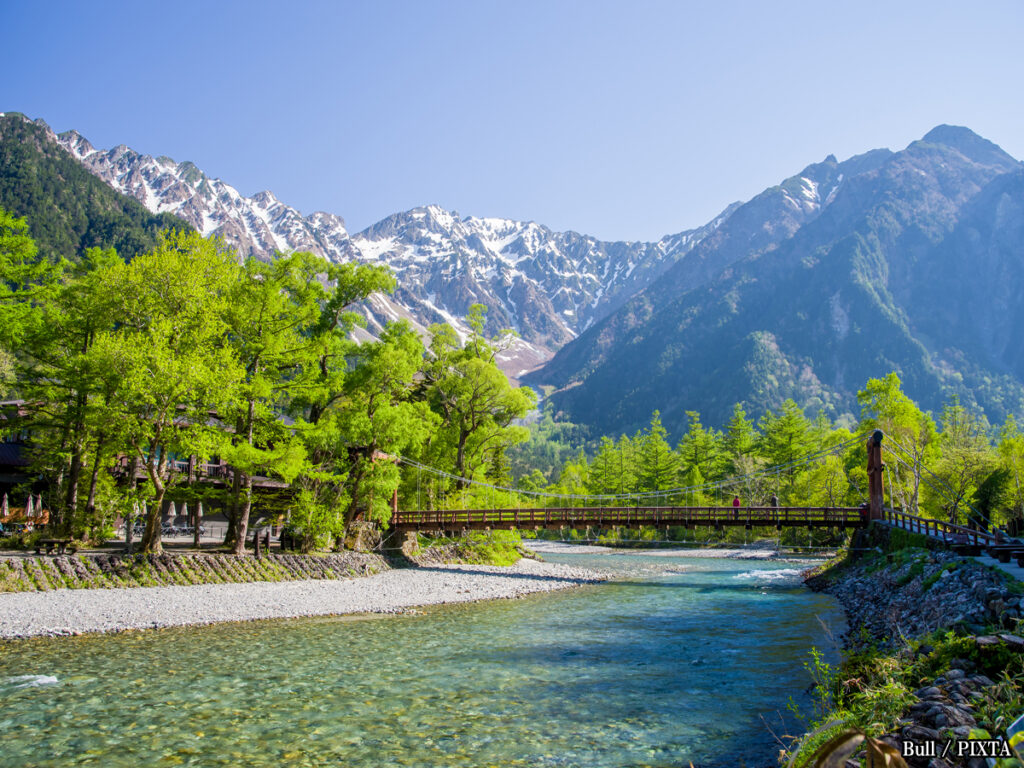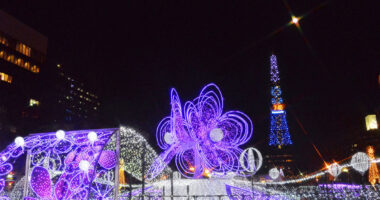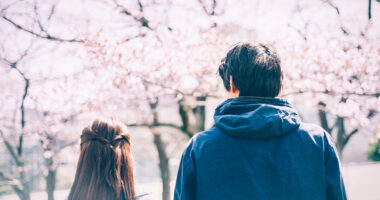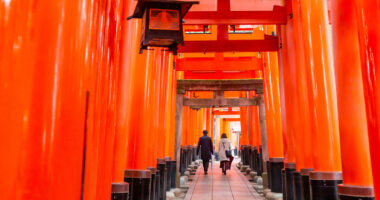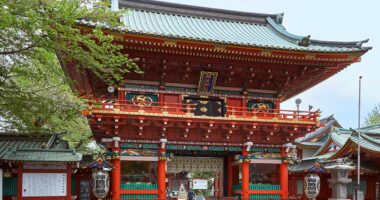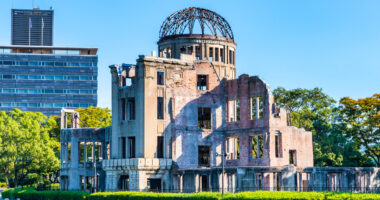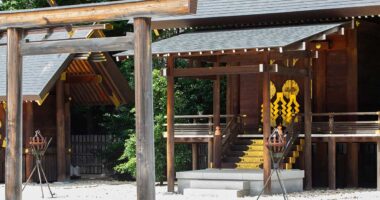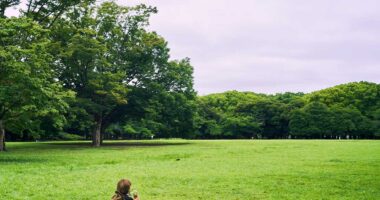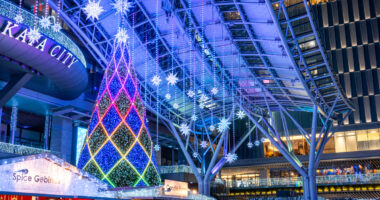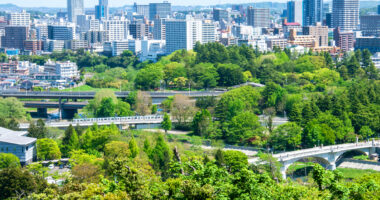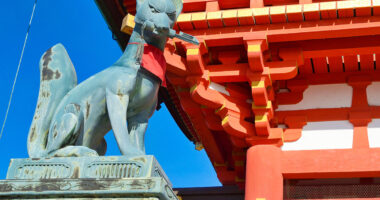Nestled in the heart of the Northern Japan Alps, Kamikōchi is a breathtaking highland valley that captivates nature lovers and hikers alike. With its pristine rivers, towering peaks, and diverse wildlife, it’s no surprise that this hidden gem is one of Japan’s most scenic destinations. Whether you’re looking for an easy day trip or an immersive hiking experience, Kamikochi hiking trails offer stunning views whenever you visit.
This guide will cover everything you need to know, from Kamikochi access to must-visit locations, accommodations, and seasonal highlights, including the vibrant foliage season.
How to get to Kamikochi: Transportation and Access
Accessing Kamikochi by public transportation
Kamikochi is only accessible by public transportation, as private vehicles are prohibited inside the park. There are also direct buses from Tokyo, Osaka, Kyoto, and Nagano.
From Tokyo
- Take the JR Limited Express “Azusa” from Shinjuku Station to Matsumoto Station (approx. 2.5 hours).
- From Matsumoto, transfer to the Matsumoto Dentetsu train to Shin-Shimashima Station (30 min).
- At Shin-Shimashima Station, transfer to a bus bound for Kamikochi (approx. 1 hour).
For up-to-date train and bus schedules, visit the official Alpico Group website.
From Osaka/Kyoto
-
1. Take the Shinkansen (Bullet Train) to Nagoya Station.
The travel time between these cities depends on the mode of transportation:
- Shinkansen (bullet train): approx. 50 minutes (Nozomi), approx. 1 hour (Hikari)
- Regular train: approx 2.5 to 3 hours
- Bus: approx 2.5 to 3.5 hours
- Car: approx 2 hours (varies with traffic)
- Shinkansen: approx. 35 minutes (Nozomi), Approx. 45 minutes (Hikari)
- Regular train: approx. 2 hours
- Bus: approx. 2 to 3 hours
- Car: approx. 1.5 to 2 hours (varies with traffic)
- Take the Matsumoto Dentetsu train to Shin-Shimashima Station (30 min).
- Transfer to a bus bound for Kamikochi (1 hour).
A. Osaka to Nagoya
B. Kyoto to Nagoya
Shinkansen is the fastest and most convenient option for both routes.
2. At Nagoya, transfer to the JR Limited Express “Shinano” to Matsumoto Station (approx. 2 hours).
3. From Matsumoto, follow the same route as Tokyo travelers:
From Takayama
Take the Nohi Bus directly from Takayama Bus Terminal to Kamikochi. This is one of the most convenient routes as it eliminates the need for multiple transfers.
For schedules and reservations, visit the Nohi Bus website.
Driving to Kamikochi (parking and shuttle buses)
While private vehicles are not allowed inside Kamikochi, travelers can drive to nearby parking areas and take a shuttle bus:
- From Tokyo: Park at Sawando Parking Lot and take a shuttle bus (approx. 30 min).
- From Kyoto and Osaka: Drive via the Hida-Kiyomi Interchange (approx. 5 hours), park at Akandana Parking Lot, and take a shuttle bus (approx. 25 min).
For parking details and shuttle bus times, visit the official Kamikochi website.
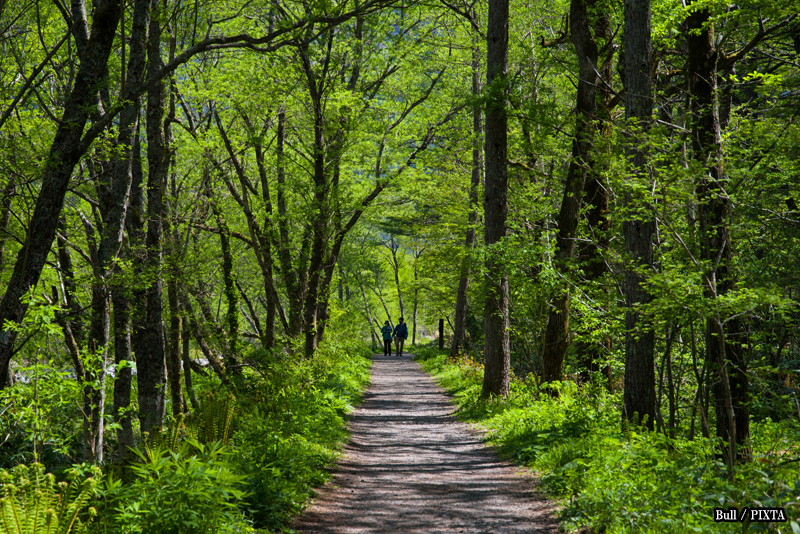
Photo for illustrative purposes
Best time to visit Kamikochi
Kamikochi is open from mid-April to mid-November, with each season offering a unique experience:
Kamikochi offers breathtaking scenery throughout the year, with each season bringing a unique charm. Since the park is closed from mid-November to mid-April, planning a visit between spring and autumn is essential.
Spring (April to June)
Spring in Kamikochi is a magical time as the snow from the Northern Japanese Alps begins to melt, revealing lush greenery. The rivers and lakes are at their clearest, reflecting the surrounding mountains. Snow remains visible on peaks like Mount Hotaka and Mount Yake (also known as Mount Yakedake), creating a beautiful contrast against the blooming rhododendrons and other alpine flowers. With fewer tourists compared to peak seasons, spring is ideal for those who want to experience Kamikochi’s beauty in a quieter setting.
Summer (July to August)
Summer is ideal for Kamikochi hiking, with comfortable temperatures and fully green landscapes. The valley is at its most vibrant, and wildlife, such as monkeys and birds, can be spotted all around. Popular trails like Myōjin Pond and Taishō Pond are in prime condition for hiking, offering breathtaking views along the way. With crystal-clear rivers and lush greenery, this is also a great time for scenic photography. The temperatures, warm daytime temperatures, ranging from 21–22°C (69–72°F), make hiking enjoyable without being too hot.
For more details on hiking routes, visit the official website.
Foliage season (September to October)
The foliage season transforms Kamikochi into one of Japan’s most breathtaking autumn destinations. The valley is painted in gold, orange, and red, with golden larches and crimson maple trees providing a stunning contrast against the deep blue sky and emerald rivers. Kappa Bridge and Taisho Pond are among the best spots to admire the autumn scenery. The cooler temperatures, ranging from 13–17°C (55–63°F), make hiking even more comfortable, attracting many visitors eager to witness the spectacular seasonal changes.
Late autumn (November)
As November approaches, Kamikochi becomes quieter as fewer visitors arrive before the seasonal closure. Light snowfall begins at higher elevations, adding a serene, winter-like atmosphere to the landscape. This time of year is perfect for those who prefer solitude and want to experience a more peaceful side of Kamikochi. With the final weeks before the park closes for winter in mid-November, visitors can enjoy the last glimpses of autumn before the area becomes inaccessible until spring.
For the latest updates on seasonal opening and closing dates, check the official website.
Top attractions in Kamikochi
Kappabashi (Kappa Bridge)
A symbol of Kamikochi, this suspension bridge offers spectacular views of the Azusa River with the Hotaka Mountains as a backdrop. It’s the perfect starting point for many Kamikochi hiking trails.
Taishō-ike (Taishō Pond)
Formed after a volcanic eruption in 1915, this pond reflects the mountains like a mirror, making it one of the most picturesque spots in Kamikochi.
Myōjin-ike (Myōjin Pond) and Hotaka Shrine Okumiya
A sacred site located near Myojin Bridge. You can enjoy a peaceful boat ride and visit Hotaka Shrine Okumiya, which is dedicated to the guardian deity of Kamikochi.
Tashiro-numa (Tashiro Marsh) and Tashiro-ike (Tashiro Pond)
A quiet area with lush vegetation, perfect for birdwatching and spotting wildlife.
Best Kamikochi hiking trails
Kamikochi hiking trails cater to all levels, from leisurely riverside walks to demanding mountain treks. Whether you’re here for a peaceful nature stroll or an adventurous climb, there’s a route for you.
Kappa Bridge to Myojin pond
One of the most popular easy hikes, this scenic trail follows the Azusa River from the famous Kappa Bridge to Myojin Pond. Along the way, you’ll pass through serene forested paths with opportunities to spot wildlife like monkeys and birds. The trail leads to Hotaka Shrine’s Myojin Shrine, where visitors can take in the tranquil pond surrounded by lush greenery.
Taisho Pond to Kappa Bridge
For those who love breathtaking scenery, the four kilometer (two-and-a-half mile) route from Taisho Pond to Kappa Bridge offers stunning reflections of the surrounding mountains in the calm waters of the pond. This gentle walk is perfect for soaking in Kamikochi’s natural beauty, with views of Mt. Yake, an active volcano, and the Hotaka mountain range. Early mornings offer the best chance for capturing the mirror-like reflections of the peaks on the pond’s surface.
Mount Yake volcano trail (five to six hours round trip)
For experienced hikers, the Mount Yake (also known as Yakedake) volcano trail is a challenging yet rewarding climb up Mount Yake, an active volcano. The steep ascent takes about five to six hours round trip, passing through forested paths and rocky terrain before reaching the crater at 2,455 meters (8,054 feet). From the summit, hikers are rewarded with panoramic views of Kamikochi and the surrounding Japanese Alps. Be prepared for rough volcanic terrain and possible sulfuric steam vents near the top.
Mt. Hotaka traverse (two-day trek)
The Mt. Hotaka traverse is an intense multi-day trek for very seasoned climbers, offering one of the most spectacular high-altitude routes in Japan. This challenging trail crosses multiple peaks of the Hotaka mountain range, reaching over three kilometers (9,842 feet) in height. Hikers will navigate steep ridges, ladders, and suspension bridges, with overnight stays in mountain huts like the Karasawa Hütte. The journey provides breathtaking views of the entire Japanese Alps, making it a bucket-list experience for serious adventurers.
For up-to-date trail conditions, maps, and safety information, check the official website.
Wildlife and nature in Kamikochi
Kamikochi is not just a paradise for hikers but also a protected ecosystem home to diverse wildlife, rare plant species, and pristine rivers. As part of Chūbu-Sangaku National Park, the region follows strict conservation rules to preserve its untouched beauty.
Native animals in Kamikochi
Visitors may spot wild macaques, deer, and even kamoshika (Japanese serow) in the forests. The Japanese macaques are commonly seen near Myojin Pond and Taisho Pond, often foraging for food along the riverside. Unlike in other parts of Japan, the macaques here are less aggressive due to limited human interaction.
Birdwatching in Kamikochi
Kamikochi is a great destination for birdwatchers, with species like the Japanese bush uguisu (warbler), varied tit, and copper pheasant. Tashiro Marsh and the Tokusawa area are prime spots for watching rare migratory birds during spring and summer. Bringing a pair of binoculars can enhance the experience.
Flora and seasonal blooms
The lush forests and marshlands of Kamikochi support a wide variety of alpine plants. In late spring, the valley comes alive with pink rhododendrons and cherry blossoms, while autumn brings golden larches and crimson maple trees during the foliage season. The area’s plant life changes dramatically with the seasons, making every visit unique.
Conservation efforts in Kamikochi
Kamikochi follows strict ecological protection laws to maintain its natural beauty. All visitors must carry out their trash. Feeding wildlife is prohibited to prevent human-wildlife conflict. These conservation efforts ensure Kamikochi remains one of Japan’s most pristine natural destinations.
Best places to stay in Kamikochi
Kamikochi offers a range of accommodations, from luxury mountain lodges to affordable guesthouses. Since it’s a popular destination, it’s best to book accommodations in advance, especially during peak seasons.
Luxury stays: onsen & riverside hotels
For those seeking a luxurious mountain retreat, Kamikochi Imperial Hotel is a top choice. This historic lodge offers elegant rooms, hot spring baths, and gourmet kaiseki meals. The hotel features five bars and restaurants, where breakfast and dinner are exclusively available to staying guests, while lunch is open to the public. Located in Kamikochi, Azumi, Matsumoto-shi, Nagano 390-1516, the hotel is accessible via the Chuo Line limited express from Shinjuku Station or the Nagano Shinkansen from Tokyo Station, with further connections via the Matsumoto Dentetsu Line and bus services. Guests from Sawando can take a bus or taxi (approx. 30 min, 15 km), and a limousine service is available with a prior reservation. For more details or reservations, guests can contact the hotel at +81-263-95-2001 / +81-263-95-2006 between 10:00 AM – 5:00 PM.
Another great option is Gosenjaku Hotel, located near Kappa Bridge. It provides stunning views and a refined atmosphere.
Mid-range stays: comfortable lodges and inns
Travelers looking for comfortable yet affordable stays can opt for Kamikochi Lemeiesta Hotel, which features cozy rooms and private open-air baths. Another excellent choice is Kamikochi Nishi-Itoya Mountain Lodge, offering authentic Japanese-style rooms and hearty meals for hikers. Conveniently located just a 10-minute walk from the Kamikochi bus terminal, this lodge provides a serene retreat in the heart of nature. It operates from late April to mid-November and accepts major credit cards, including Visa, Mastercard, American Express, and Diners Club. For inquiries, visitors can contact the lodge via phone at 0263-95-2206 or email at yoyaku@nishiitoya.com.
Budget-friendly options: mountain huts and guesthouses
For budget travelers, yamagoya (mountain huts) and guesthouses provide affordable lodging. and offer simple but scenic stays, perfect for hikers planning long treks in Kamikochi. Tokusawa-en and Yokoo Sanso offer simple but scenic stays, perfect for hikers planning long treks in Kamikochi.
Tokusawa-en
- Address: 4468 Kamikochi, Matsumoto-shi, Nagano
- Access: About a 2-hour walk (4.35 miles) from Kamikochi Bus Stop
- Phone Number: 0263-95-2508
- Reservations: By phone or via the official website
- Payment: Cash only (credit cards are not accepted)
- Hours: April 26th – November 3rd
- Other Information:
- Please plan to arrive by 4:00 PM for safety reasons.
- Food allergies declared on the day of stay cannot be accommodated.
- Vegan dietary options are not available.
- Guests should bring rainwear in case of sudden rain.
- Website: https://www.tokusawaen.com/english/english.html
Yokoo-Sanso
- Address: Kamikochi, Azumi, Matsumoto-shi, Nagano
- Access: About a 2.5-hour walk (5.5 miles) from Kamikochi Bus Stop
- Phone Number: 0263-95-2421
- Reservations: By phone only
- Payment: Cash only (credit cards are not accepted)
- Hours: Late April – End of October
- Other Information:
- No shower facilities
- Guests are expected to bring their own toiletries
- Meals are included, but vegetarian options are limited
- Website: https://www.yokoo-sanso.co.jp/

Photo for illustrative purposes
Must-try local cuisine in Kamikochi
A trip to Kamikochi isn’t complete without trying its traditional mountain cuisine. The local food scene focuses on fresh river fish, soba noodles, and regional delicacies that pair perfectly with the natural surroundings.
Grilled river fish: iwana and ayu
Iwana (Japanese char) and ayu (sweetfish) are locally caught river fish grilled over charcoal. These are often served at local mountain huts and dining halls at ryokan (traditional Japanese inns), offering a true taste of Kamikochi ’s wilderness. Try it at Shimizuya Ryokan or Gosenjaku Kitchen.
Chuokan Ryokan Shimizuya
- Address: 4269-5 Kamikochi, Azumi, Matsumoto-shi, Nagano
- Access: About a 7-minute walk from the Kamikochi Bus Stop
- Phone Number: 0263-95-2131
- Reservations: By phone or via the official Kamikochi website
- Payment: Cash only (credit cards are not accepted)
- Hours: Mid-April – Mid-November
- Other Information:
- Traditional Japanese inn with tatami rooms
- Private bathrooms available in some rooms
- Meals feature seasonal local ingredients
- Website: https://www.kamikochi.or.jp/en/stay/shimizuya
Gosenjaku Kitchen
- Address: 4469-1 Kamikochi, Azumi, Matsumoto-shi, Nagano
- Access: About a 3-minute walk from the Kamikochi Bus Stop
- Phone Number: 0263-95-2036
- Reservations: Not required for the café; accepted for lodging via phone or website
- Payment: Credit cards accepted
- Hours: Late April – Early November
- Other Information:
- Serves coffee, snacks, and light meals
- Offers souvenir goods and local crafts
- Attached to the Gosenjaku lodge, which provides overnight stays
- Website: Gosenjaku Kitchen
Shinshū soba noodles
Nagano Prefecture is famous for Shinshū soba, a buckwheat noodle dish served hot or cold. Visitors can enjoy freshly made soba at Kamikochi Soba Restaurant, which offers a scenic riverside dining experience.
Hōba miso
Hōba miso (literally “magnolia leaf miso”) is a traditional Nagano and Gifu dish, where miso paste is grilled on a magnolia leaf with vegetables and tofu. It’s a must-try for those looking for authentic mountain flavors. Some ryokan serve this specialty, such as Kamikochi Lemeiesta Hotel. Located at 4469-1 Azumi, Matsumoto City, Nagano, this elegant hotel is accessible via the Nagano Shinkansen, Shinonoi Line, and Matsumoto Dentetsu Line, followed by a Matsumoto Dentetsu bus ride and a 10-minute walk. The hotel operates from April to November and offers a restaurant that requires reservations by 12:00 PM the day before, though the café and bar do not require reservations. Due to the lack of streetlights in Kamikochi, guests are advised to arrive before 5:00 PM. For inquiries, contact the hotel at +81-263-95-2121 or 0263-36-5981 (business hours 10:00 AM – 4:00 PM) or via email at lemeiesta@alpico.co.jp.
Japanese sansai ryōri (mountain vegetable cuisine)
Kamikochi’s highland location makes it an excellent place for seasonal sansai ryōri (mountain vegetable cuisine). Dishes featuring wild greens, mushrooms, and mountain herbs can be found at traditional inns and restaurants, such as Nishi-Itoya Mountain Lodge.
NISHI-ITOYA MOUNTAIN LODGE
- Address: 4468 Kamikochi, Azumi, Matsumoto-shi, Nagano
- Access: Approx. 2-hour walk (4.3 miles) from the Kamikochi Bus Stop
- Phone Number: 0263-95-2412
- Reservations: By phone or via their official website
- Payment: Cash only
- Hours: Late April – Late October
- Other Information:
- Simple lodge with basic shared facilities
- Popular with experienced hikers and trekkers
- Guests should bring their own toiletries and headlamps
- Website: https://www.nishiitoya.com/en/
Final tips for visiting Kamikochi
No private cars allowed
Kamikochi is a protected area, and private vehicles are not permitted. Visitors must take public transportation, taxis, or tour buses to access the region. Plan your journey in advance and check the bus schedules to ensure a smooth trip.
Bring cash
Many shops, lodges, and restaurants do not accept credit cards, so it’s best to carry enough cash for food, souvenirs, and transportation. ATMs are scarce in Kamikochi , so withdraw money before arriving.
Prepare for unpredictable weather
Even in summer, temperatures can drop at night, so pack warm clothing and rain gear. If you’re planning a Kamikochi hiking trip, ensure you have sturdy footwear and check the forecast before setting out.
Respect nature
Kamikochi is a protected national park, so visitors must follow conservation rules. Stay on designated trails, do not feed the wildlife, and avoid picking plants. Keeping the environment clean ensures that future generations can enjoy Kamikochi’s natural beauty.
Whether you visit during the vibrant foliage season or for an unforgettable Kamikochi hiking adventure, this stunning alpine valley offers something for every nature lover. Plan your trip, immerse yourself in the breathtaking scenery, and experience one of Japan’s most beautiful destinations.
